
Create an Event Timeline Easily with Customizable Templates
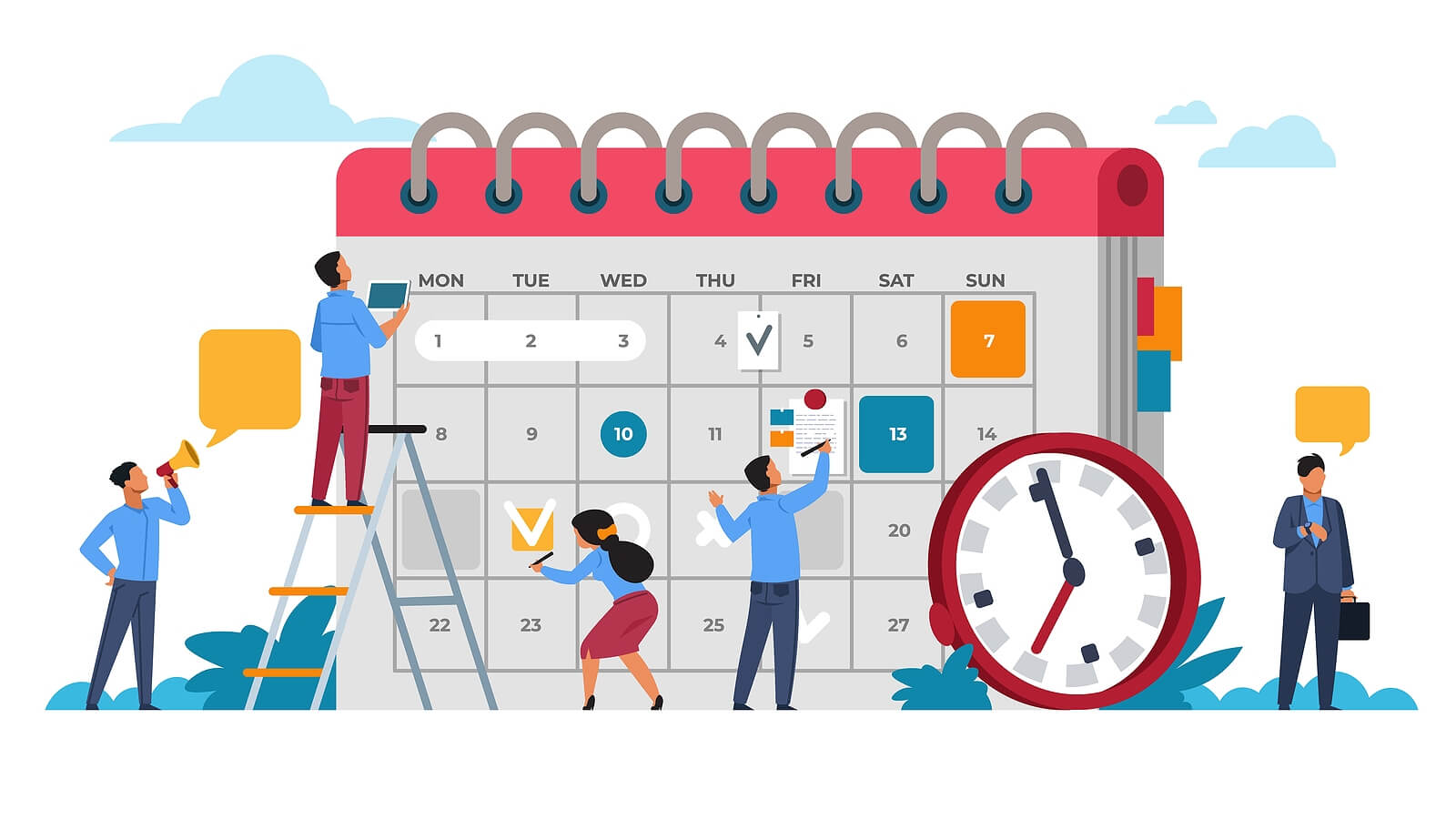
Regardless of the event size or purpose, there are numerous factors you should worry about. Everything needs to be carefully planned for successful results, from the event budget to the timelines you present to your key stakeholders.
Since several factors can impact these critical details, most event planners and managers create a document called the event timeline or event planning checklist. This powerful tool helps with the event logistics and ensures everything gets delivered on time and according to the specifications.
In this article, we will show you how to make the perfect event timeline template for your needs. Make sure to follow all the steps correctly to end up with a well-structured document that can help you achieve your event goals and generate the expected results.
Create an Event Timeline Easily with Customizable Templates
What Is an Event Timeline Template
As the name suggests, the event timeline document is a tool managers and event owners use to plan the best strategies to ensure everything runs smoothly and as expected throughout the planning and execution steps. From the event’s date to the planning process, everything must be analyzed and properly listed for the event planning timeline template to work.
Event timelines not only help you with tracking the event date and the project’s progress, but also facilitate creating organized checklists and tasks to avoid any problems before and after the event starts.
Most managers think that creating event timeline templates is strict for complex and big projects, when in fact, even a small event can benefit from these schedules and checklists.
Why Creating an Event Planning Schedule Can Bring Benefits
Making these timelines can bring numerous benefits, whether working on an amateur project or with event professionals. For example, by having a timeline template, you can establish event goals and use them to track how much of the project was completed and evaluate the overall results.
Moreover, this tool ensures that event suppliers and other vital parties deliver everything on time to avoid surprises. It also becomes a game changer for budget control and optimization.
If you want to get the best results on your next event, an event planner template is the right choice. But to reach these goals, your document must feature the correct data and be aligned with your objectives.
Types of Event Timelines
Although all event timeline templates and checklists have the same main objectives, there are several types of documents you can use to achieve these goals. Choosing the right kind can help the tasks and planning phase to be even more efficient by featuring exactly what you need.
If you don’t know the different types of timeline templates, don’t worry. Here are the main ones and their primary purposes:
Pre-Event Timeline
The pre-event timeline is responsible for gathering all necessary information for building a strategic plan for all steps that must be completed due the event day. It tends to be the most extensive planning process since it involves more steps.
The main factors that guide this kind of planning are the crucial dates involved and the deadline for delivering the final results. It regards tasks such as gathering equipment, hiring necessary third-party services, and acquiring supplies.
It is a list of everything that needs to be done before the event.
Event Day Timeline
It is also common to create specific timelines for the event day, covering all tasks that must be performed during the event. From security training to the keynote speaker in case of a presentation, everything should be clear in this document to ensure everything goes as planned.
Some events need more protocols and procedures than others. One great example is live events. The event planner must ensure everything is set up so once the live event starts, there is no need to interrupt it.
This kind of template must feature everything needed and expected from the moment the event starts to the closing time. The size of this document will depend on the type of event and its size.
Post-Event Timeline
Following the order, the next type of event template is the post-event document. As the name suggests, it tracks tasks and timeline information regarding your post-event efforts.
Some common activities featured in this document include cleaning up and ensuring all the equipment is properly packed up. Depending on the size of the event, these activities can take more than just one day to be completed.
Also, every post-event project should have a closure meeting as the final step. This meeting will discuss the event's results and the main points that need to be highlighted.
Long-Term Timeline
This is the most complete template type and features all three timelines previously listed into one. The objective of this document is to list all tasks, services, and information related to all steps and stages of the event being developed.
From the first efforts to the final meeting, this is the best document if you want to have all the necessary data in one place. It is usually used in longer projects that need more detailed instructions.
The tasks and information should obviously be listed in chronological order for better results. This way, the team, and other stakeholders can easily identify what still needs to be done and in what time frame.
Vital Parts of an Event Planning Timeline
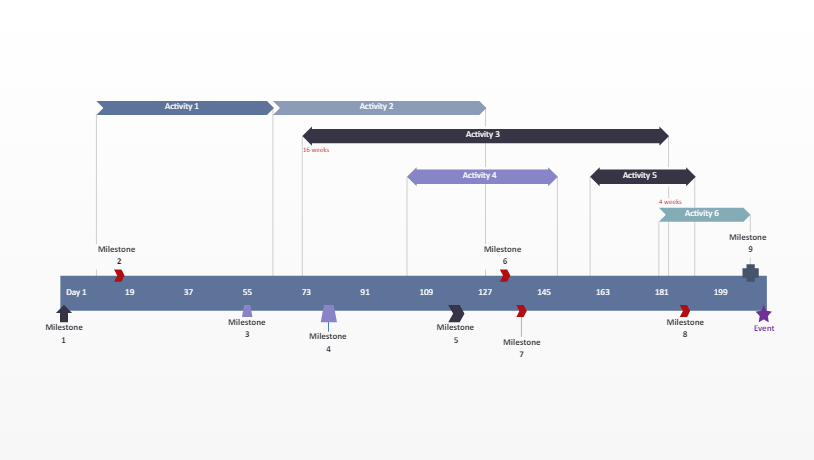
Now that you know the main types of templates, it is time to see some critical information to feature in your event timeline for better organization and optimized results. These items apply to any kind of template, and each one impacts a different aspect of your strategy.
Make sure to take a look at each one carefully. Here are the main parts of an event planning timeline:
Project Identification
The first action you need to take when creating a timeline template is to identify the event or project it regards. You don’t need deep descriptions in this part.
Something as simple as a title with the event's name can be enough for proper identification. Since companies can have multiple event timelines planned simultaneously, having a title avoids confusion and mistaking one event for another. Moreover, it also helps your document to be easily identifiable and organized.
List Tasks
Next, you need to list all tasks necessary for the event to be completed and occur as expected. It is also important to list these tasks in chronological order because it will make it much easier to plan the next steps of your document.
You can also add space for notes to clarify the tasks and important details to whoever gets responsible for completing them. Online software is the best option for making these slight alterations and adjustments to the document.
Assign the Teams Responsible for Each Activity
After listing all tasks, assigning team responsibilities becomes way easier. The benefit of making the list chronologically is that you can effectively prioritize responsibilities even before building the timeline itself.
The number of team members will depend on the type of action they are assigned and their complexity. These decisions should also be based on your due dates and what you need to deliver them on time.
Remember that unexpected events can happen, so be prepared for any inconvenience. This way, there are no chances of delaying deliveries and other events planned.
Create Goals and Milestones
Every timeline needs to have goals and milestones in its structure to better visualize how much was accomplished and what still needs to be done. Along with that, reaching these goals also help team members to stay motivated and productive.
Milestones should represent key steps of the project. Make sure to assign them to critical moments that represent significant progress in the overall process.
It is also vital to include the right number of milestones. Ensure not to include too many goals since they should represent only critical moments, and having more than necessary might not be suitable for the organization.
Determine Budget
The determined budget for the entire operation is another data that can impact all aspects of the event planning process. This information should be clearly identified in the event master plan so that when creating strategies for the execution, they ensure it fits the available budget.
Making it one of the primary details in your planning process, this information allows you to determine what tasks take precedence and what can be considered secondary.
Moreover, depending on the budget, the company responsible for the event can also plan on inviting special guests for these activities. You must ensure the elaborated plan makes sense considering how much you have at your disposal for planning an event.
Choose Your Main Vendors
If you’re planning an open event, like a music concert, you’ll also have to plan which vendors will offer tickets. It is one of the most critical parts, and clear communication regarding this party is vital.
Your timeline should also feature marketing actions to promote these vendors and get people to acquire the tickets. From a blog post to TikTok videos, the best strategy will depend on the type of event you’re promoting and the target audience you are trying to reach.
Choosing the right venue and other vendors is one of the most important steps. Make sure to select professionals to avoid future problems regarding ticket sales.
Plan on Event Marketing Actions
More than just promoting the vendors, you also need to plan promotional activities for the event itself. You should reserve some space on the timeline for these marketing actions.
Most companies have a specialized marketing sector, but we highly recommend hiring a professional marketing agency if this is not the case. This way, you won’t need to assign other teams for this task and can run the project at total efficiency.
Your marketing actions must be aligned with multiple aspects of the strategy plan, including the budget, type of event, and target audience. You can do several kinds of marketing actions, from printed materials to TV commercials, so choose one considering the previously mentioned factors.
Make Suppliers Lists and Orders
Suppliers are crucial parties for any event since they are responsible for providing any material needed for the project to become a reality. Your timeline should also feature all occasions in which suppliers will be contacted, and along with that, it is also essential to list all supplies that will be purchased or borrowed for the event.
Along with helping with organization, it also ensures the teams don’t forget any important item that might impact the event. You can use name badges to identify the supplier or just put the item's name. Although the event timeline dismisses the need for extra templates for its tasks, you can create other documents to complement it and make it more organized, such as a list of suppliers.
Tips for Better Management of Your Timeline Templates
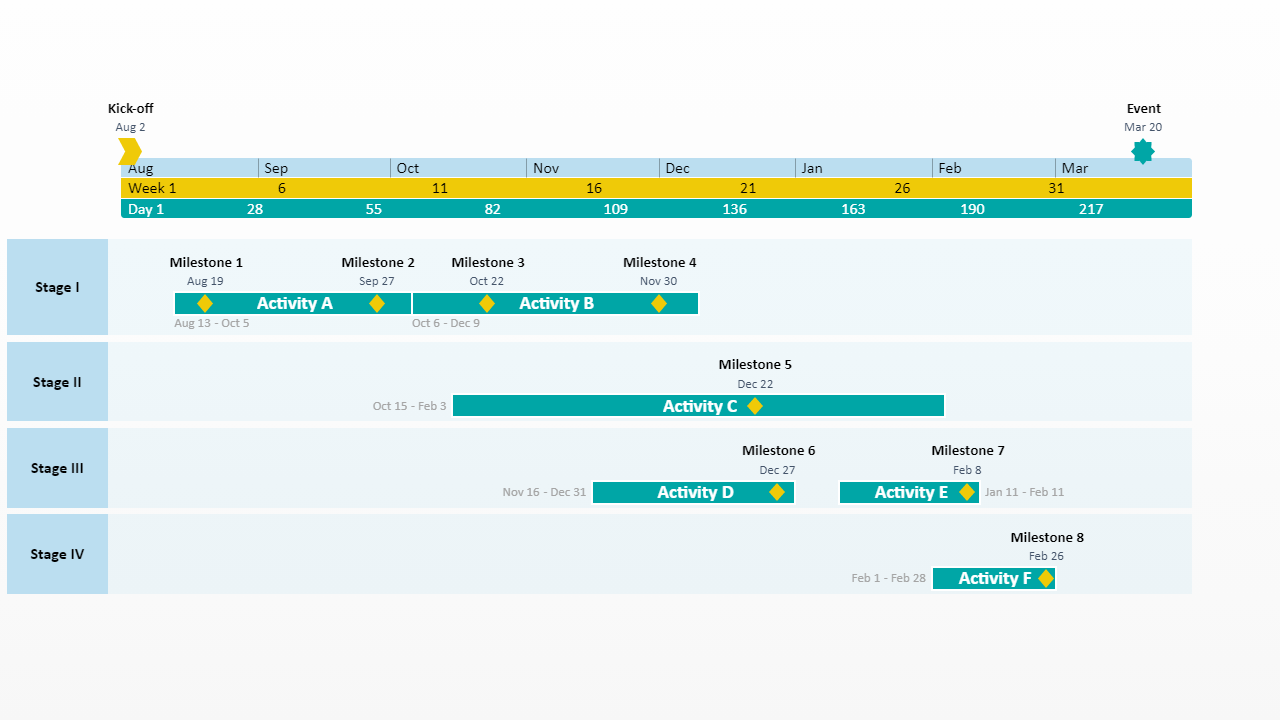
If you want to create the best event planning timeline possible, certain practices are indispensable. We will show you the main tips to ensure the best performance out of your planning timeline.
Make sure to follow each one correctly, and you’ll instantly notice an increase in the performance of your templates. Here are the main actions you can take for it:
Keep Your Document Updated
The event planning timeline is a living document and should be updated as soon as a new item is completed, or something changes during the project. For this to work optimally, assigning someone responsible for taking care of the timeline template is recommended.
Keeping it constantly updated ensures the entire team is on the same page and all your tasks get organized. Moreover, it also helps the team visualize progress and see how much is left to do until the deadline.
Create Different Versions
Most event projects will require multiple versions of an event planning timeline. It is normal to create multiple drafts until reaching the final version.
Ensure that your strategy is solid and aligned with every aspect of the project. During the template planning, you’ll find multiple challenges trying to fit every deliverable on a date and according to the available budget. With this comes the necessity of creating the document various times until achieving the desired version.
It is a normal process, so create different versions before sticking to the final one. This way, you will end up with the best option between them for a successful event.
Use Visually Appealing Templates
Choosing colorful templates is not just a matter of aesthetics. These color codes directly impact visualization and document efficiency.
If you choose a colorful template, it becomes easier to visualize each task and what needs to be done. Also, it helps every team member to better understand what still needs to be completed and the time left until the deadline.
Several tools, like Excel, let you create visually attractive tools that are not just organized but easy to understand. This way, your project becomes more optimized.
Where to Create Event Planning Timelines
When it comes to creating your own event timeline document, there are tons of options available. From known software to specialized programs, each one has its own features to help you create the perfect timeline template.
Among all the options available, we highly recommend using Microsoft Excel for this task. It not only has the best tools and features but is also an industry standard. This means that you won’t need extra software to perform your other business tasks.
If you don’t have a Microsoft Office activation key, you can find one at RoyalCDKeys for a considerably lower price. This way, you get everything you need and still save money.
Ready to Use Event Timeline Template
If you don’t want to create your timeline template from scratch, there is no problem. Here are some free examples you can download and use:
Template #1
General project timeline template. A document that can be used for creating any kind of timeline.
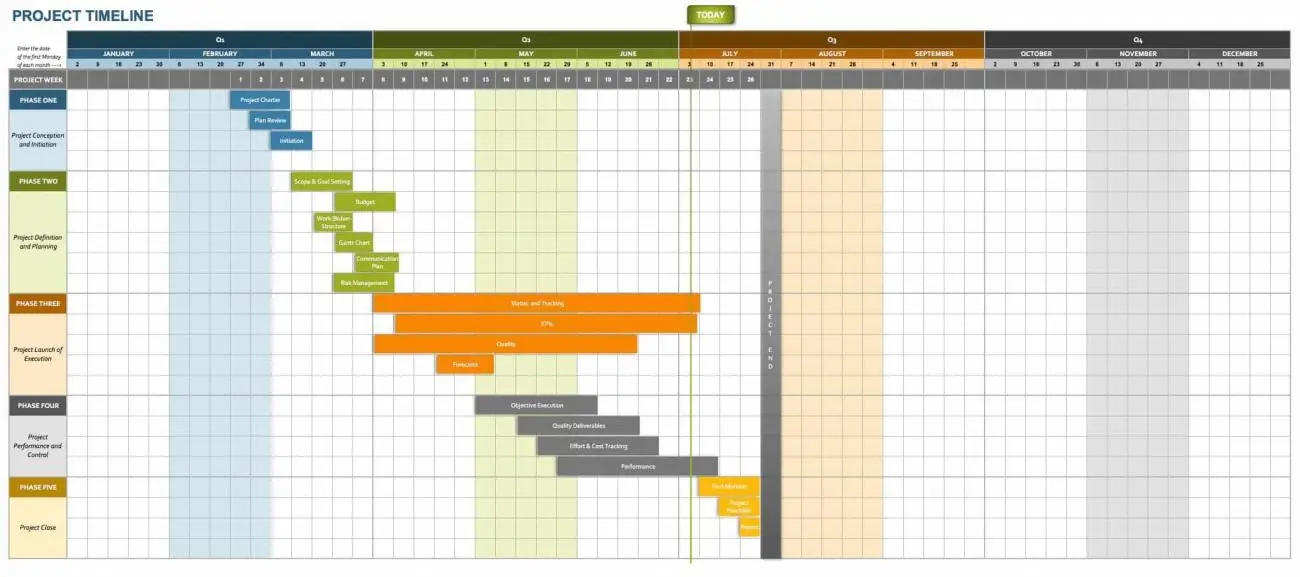
Template #2
Simple timeline template. It can be used for detailed descriptions of each step of the process and create color codes for each team.
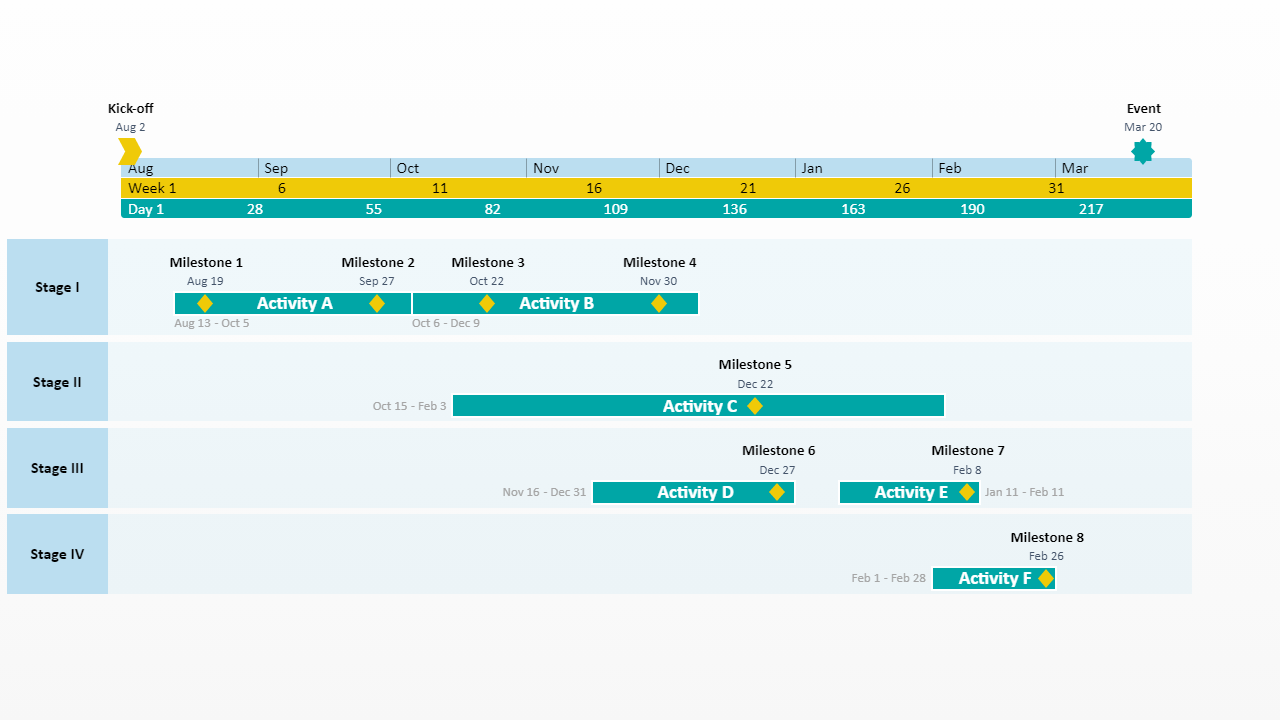
Template #3
Event marketing timeline template. Document featuring all tools necessary for creating marketing strategies for events.
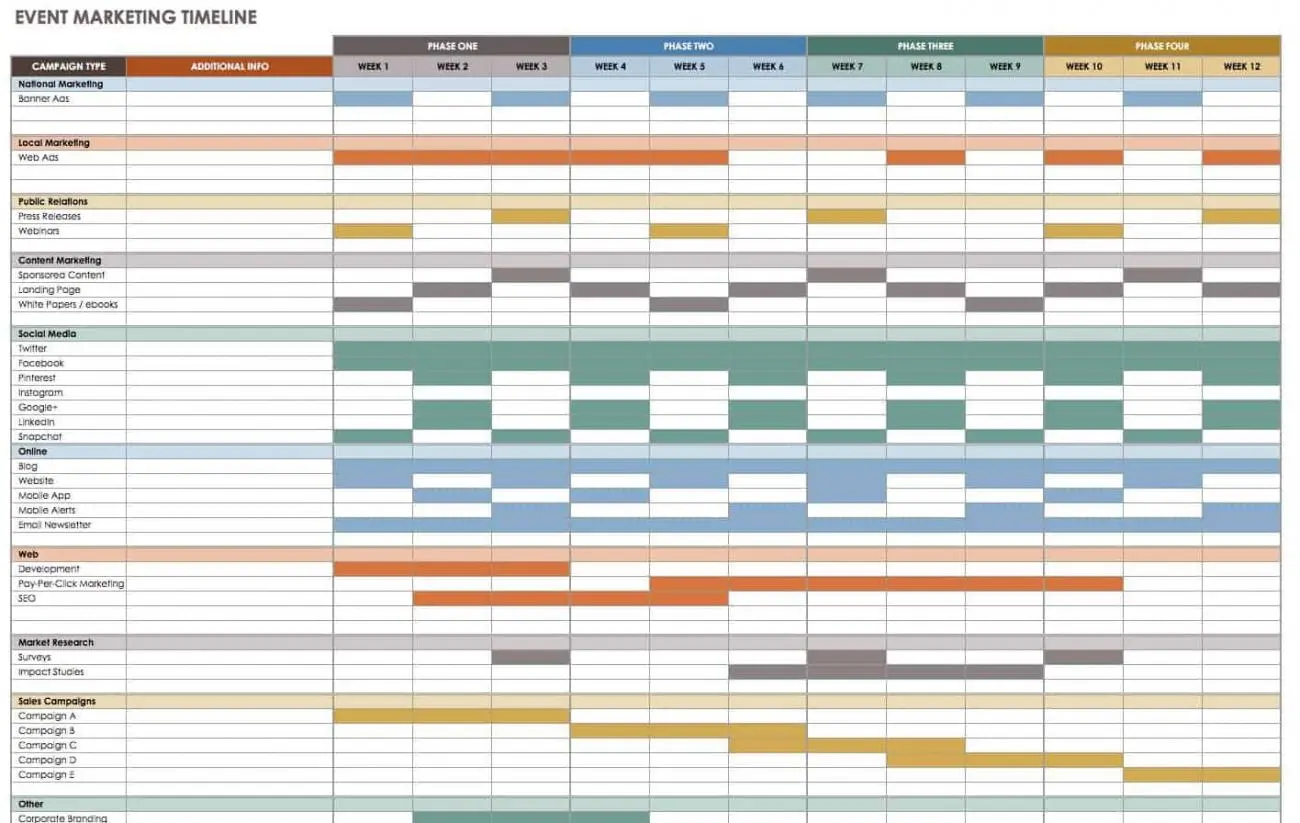
Time to Start Building Your Event Timeline
An event can be a complex project to execute since there are several different aspects that you must worry about and plan carefully. Everything will impact your strategy, from the budget to the number of team members available.
To help with this, creating an event timeline document is indispensable. It can be a game changer in every aspect, from the beginning to the end.
Now that you know everything you need, it is time to start creating your event timeline. Follow all steps, and you’ll have the perfect document for your projects.















